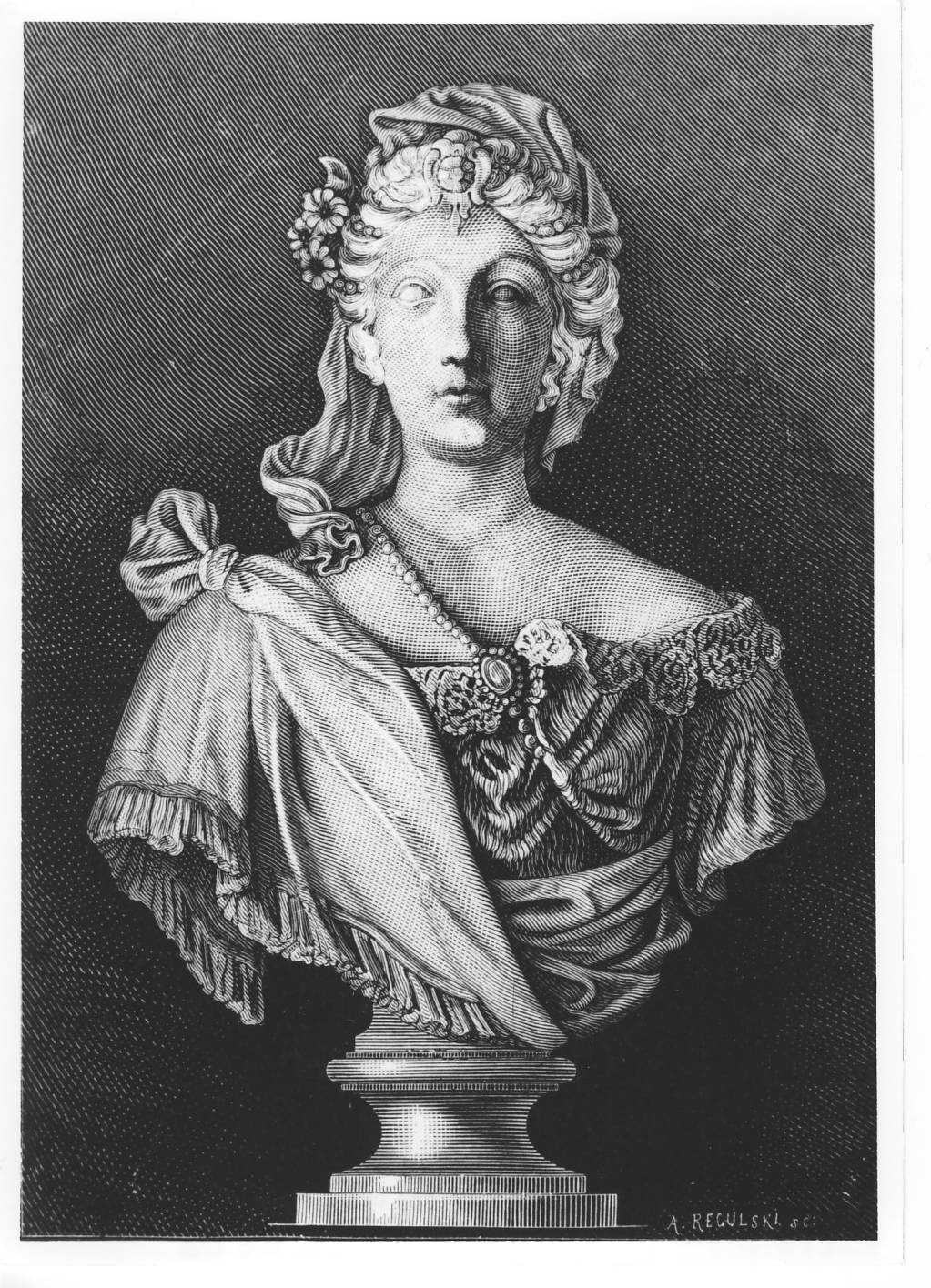
A remarkably modest sculpted iconography of Marie Casimire (1641–1716), King Jan III Sobieski’s wife and thus the Queen of Poland, is practically limited to one example kept in the Wilanów collection. It is the queen’s bust carved in the Carrara marble (total height of the statue: 74 cm), recorded in the Wilanów inventories in 1834 and 1840. The statue was first mentioned in a publication by Hipolit Skimborowicz and Wojciech Gerson entitled Willanów. Album widoków i pamiątek, oraz kopje z obrazów Galeryi Willanowskiej [Willanów. Album of views, memorabilia and copies of paintings from the Willanów Gallery] (Warszawa 1877), where it was referred to as an object contemporarily exhibited in the Mirror Cabinet. Made in ca. 1680, the bust represents Marie Casimire devoid of royal majesty and glory, but simply as a beautiful woman. Her rather modest dress is decorated only with a necklace of large pearls and a light scarf with thick tassels, hanging over her shoulder and tied in a fanciful knot. The queen’s beauty is highlighted by a magnificent hairstyle with a diadem on her forehead, underlining the model’s high rank. Marie Casimire’s hair is interlaced with pearls (her favourite gem) and covered with a fanciful scarf draped like a bonnet whose one end falls onto her right shoulder. A bunch of flowers fixed above the right ear is an expression of subtle coquetry or a harbinger of a successful married life.
Calm in structure, he statue is marked by meticulous decorativeness in position and modelling of details discerned in the model’s dress and hairstyle, with the sculptor successfully recreating the illusion of fabric-like structure of silk and lace. Although the queen’s facial features were reconstructed with individual characteristics of a portrait, they remain cool, dispassionate, somehow stiffened by smooth eyeballs with no pupils. The gentle and refined bust is modelled flat, nearly graphically, as if it was meant to be viewed only from the front. Initially the sculpture was associated with an anonymous French artist from 1675–1700 (1967). However, in 1978 Dariusz Kaczmarzyk attributed its authorship to Jacques Prou the Younger (1655–1706), a son and pupil of Jacques Prou the Elder. Apart from being employed at decorating the Louvre, the Palace of Versailles and the Marly Palace, the artist sculpted a number of royal busts, including those of Louis XIV and Philippe, Duke of Orléans. Kaczmarzyk pointed out that in case of Marie Casimire’s bust the sculptor made use of her copperplate portrait created by Jacques Blondeau, copied as a mirror image and rendered three-dimensional. The alleged work of Prou the Younger was made in Paris, presumably commissioned by Jan III who kept his political and cultural agents in the French capital. Perhaps the intermediary was the king’s brother-in-law, François Gaston de Bethune, who in 1676 and after 1685 fulfilled the function of the ambassador to Poland for Louis XIV. It seems that following King Sobieski’s death the discussed sculpture never left Poland (indicated by its excellent preservation), despite a hand-written record in the inventory Katalog obrazów i etrusków [Catalogue of paintings and Etruscan artefacts] from the mid-nineteenth century, which reads, Portrait of the queen made of white marble purchased by Potocki in Paris in 1808. However, the quoted entry is misleading, as a detailed list of expenses made by Stanisław Kostka Potocki in 1808 contains no such purchase which, considering the significance of the buy, could not possibly be omitted. The unique sculpted effigy of Marie Casimire was reproduced by Aleksander Regulski in a woodcut based on a drawing by Stanisław Witkiewicz, made from the original. The print occupied page 111 of the aforementioned publication by Skimborowicz and Gerson.
Aleksander Regulski, based on a drawing by Stanisław Witkiewicz, according to a sculpture attributed to Jacques Prou the Younger: Portrait of Queen Mary Casimire, woodcut, publ. 1877.
We would like to inform that for the purpose of optimisation of content available on our website and its customisation according to your needs, we use information stored by means of cookies on the Users' end devices. You can control cookies by means of your Internet browser settings. Further use of our website without change of the browser settings means that you accept the use of cookies. For more information on cookies used by us and to feel comfortable about this subject, please familiarise yourselves with our Privacy Policy.
✓ I understand